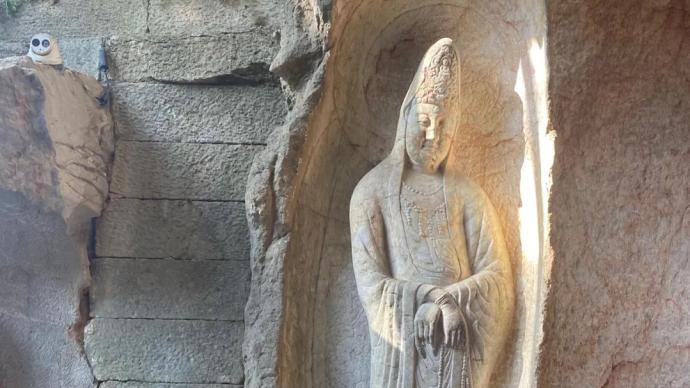
Zhejiang is the land of Wu and Yue where the sea and land meet. Since the Eastern Han Dynasty and the Three Kingdoms period, Buddhism has been introduced into the territory. In general, more than 80% of the caves with statues in ancient Zhejiang grottoes are concentrated in the Hangzhou area, especially in the Wuyue Kingdom and the Yuan Dynasty in the Five Dynasties and the Yuan Dynasty. Hangzhou can be called the center of Chinese grotto statues after the 10th century. The statues in the Zhejiang Grottoes include a variety of Buddhist statues such as Buddhas, Bodhisattvas, disciples, Arhats, eminent monks, heavenly kings, and boys, as well as a small number of Taoist, Confucian and folk belief statues. The rich variety of stone inscriptions is also a major feature of ancient Zhejiang grotto statues.
1. A brief history of the development of Zhejiang Grottoes
Zhejiang is the land of Wu and Yue where the sea and land meet. Since the Eastern Han Dynasty and the Three Kingdoms period, Buddhism has been introduced into the territory. Since the Eastern Jin Dynasty, eminent monks gathered in the area of Yanxian County, Kuaiji County, and talked about the Taoism. During the Qiliang period of the Southern Dynasties, the Maitreya Buddha in Shicheng Mountain in Yanxian County (now Xinchang) was excavated to be the earliest large-scale grotto statue in southern my country; the Ashoka Temple in Yanxian County (now Ningbo) was recognized as the number one Sakyamuni stupa in China at that time . The existing Southern Dynasty grotto temples in Zhejiang mainly include Xinchang Giant Buddha (that is, Shicheng Mountain Giant Buddha in Yanxian County), Xinchang Thousand Buddha Rocks, etc. It can be seen that Shanxian County played an important role in Jiangnan Buddhism during the Eastern Jin and Southern Dynasties.
Zhiyi, an eminent monk in the Sui Dynasty, founded the Tiantai School in Tiantai Mountain. By the Tang Dynasty, Ashoka Temple in Tuan County, Mingzhou, and Tiantai Mountain in Taizhou had become famous Buddhist holy places in East Asia. After the Anshi Rebellion and the annihilation of Buddhism in Huichang, the center of Chinese Buddhism moved south, and Zhejiang became the center of Buddhism after the Tang Dynasty. In Yuezhou, Hangzhou, Taizhou, Wenzhou, Wuzhou and other places, there are many large temples and famous monks. There are few existing Tang Dynasty grottoes in Zhejiang, mainly including Shaoxing Yangshan Giant Buddha, Shaoxing Keyan Giant Buddha, Jiande Yuquan Temple Stone Buddha, etc., which are concentrated in Yuezhou area, and mainly include giant Buddha statues.
During the Wuyue Kingdom period of the Five Dynasties, the three generations and five kings of the Qian family pursued the national policy of "doing good to China" and "protecting the country and the people", and vigorously supported Buddhism. Buddhism in the Wuyue period was closely related to kingship and had a strong color of protecting the country. After nearly a hundred years of development, the Wuyue Kingdom became the "Southeast Buddhist Country". The last king, Qian Chu, paid tribute to the Buddha with sincerity, and appointed eminent monks of the Fayan Sect, such as Deshao and Yanshou, to encourage believers to make vows to the Pure Land and build sutra images. In Hangzhou, the capital of the country, the construction of temples and towers and the craftsmanship of statues have reached their peak. The existing grottoes in the Wuyue Kingdom period are almost all distributed around the West Lake in Hangzhou, including Shengguo Temple, Ziyan Courtyard (Ciyunling), Shilong Courtyard, Shennita Pagoda, Lingji Courtyard, Stone House Courtyard, Yanxia Courtyard, Huiri Yongming Courtyard There are statues in the courtyard (Jingci Temple), Tianlong Temple, Xiangyan Temple (Jiuyao Mountain) and other temples, some of which belong to the imperial family of Qian's family.
After the Northern Song Dynasty, Zen Buddhism and Pure Land dominated the Buddhist beliefs in the Zhejiang and Zhejiang regions. The Southern Song Dynasty made Lin'an the capital, Zhejiang became a national Buddhist center, and Zen Buddhism flourished. The official establishment of the "five mountains and ten temples" system of Zen temples, Zhejiang is one of the most outstanding, accounting for its five mountains and six temples. The monks advocated and practiced the belief in the Pure Land, and among the people, statues of pagodas and Buddhist associations were popular. At the same time, Taoism, as a national religion, is also very prosperous. Statues in the Northern Song Dynasty are mainly distributed in Hangzhou Qinglin Cave, Yuru Cave, Shifoyuan, Dafo Temple, etc.; in the Southern Song Dynasty, there are Taoist statues in Tongxuanguan in Hangzhou, Nanguanyin Cave, Ningbo Butuo Cave, etc. The development trend of "integration of education".
After the Song and Yuan Dynasties, Han Buddhism declined. Tibetan Buddhism was regarded as the state religion, and with the support of the royal family of the Yuan Dynasty, it deeply influenced the Han region. The Presidential Office of the Buddhist Capitals of the Jianghuai Zhulu Roads, set up in Hangzhou, is managed by Yang Lianzhenjia, a native of Xixia, and is located in Yongfu Temple in front of Feilai Peak. Yang Lianzhenjia supported the excavation of the Feilai Peak statue group, which brought together two different styles of statue art: the Zen statue in the Southern Song Dynasty and the Sakya statue in the Yuan Dynasty. It was an attempt to integrate Chinese and Tibetan cultures at the turn of the Song and Yuan Dynasties. The Baiyun Sect was respected by the rulers of the Yuan Dynasty and was extremely powerful. The Puning Temple in Yuhang Nanshan was the missionary center of the Baiyun Sect.
During the Ming and Qing Dynasties, the integration of the three religions became the mainstream, and religious beliefs became more secular. The belief in Guanyin was popular, and Mount Putuo was established as the Dojo of Guanyin Bodhisattva in the Ming Dynasty. Family and folk statue offerings have gradually replaced temple statue offerings, and themes such as cloth bag Maitreya and Guanyin sending children are popular among believers. Statues with Taoism and Confucianism also came into being, and even formed a statue niche combining the three religions. The stone carvings of this period are all over the province, such as Hangzhou Gem Mountain, Xishan Nunnery, Shaoxing Stone House Temple, Yuyao Hugongyan, Putuo Mountain Chaoyin Cave, etc.
In general, more than 80% of the ancient cave statues in Zhejiang are concentrated in the Hangzhou area, especially in the Wuyue Kingdom of the Five Dynasties and the Yuan Dynasty. Because Hangzhou, as the capital of the Wuyue Kingdom and the Southern Song Dynasty, has been the center of political, economic, cultural and religious activities in the Zhejiang and Zhejiang regions since the Five Dynasties. Furthermore, Hangzhou can even be called the center of Chinese grotto statues after the 10th century.

Group photo of the investigation team in front of the statue of the Great Buddha Temple in Baotou Mountain during the "Special Investigation of Zhejiang Grotto Temples" in 2021
2. Characteristics of the niches in the Zhejiang GrottoesGrottoes were originally a form of Buddhist architecture in India. Buddhism advocates seclusion, monks choose to dig grottoes in secluded places outside the city, and practice in the form of "rock dwellings" and "cave dwellings". From the 4th to the 7th century, the earliest grottoes appeared in my country, modeled on the Indian and Central Asian grotto systems, and distributed in Xinjiang, Hexi, Central Plains and other regions, such as Kizil Grottoes, Dunhuang Mogao Grottoes, Yongjing Bingling Temple Grottoes, Tianshui Mai Grottoes. Jishan Grottoes, Yungang Grottoes, Longmen Grottoes, etc. In the late 5th century, the grotto system was introduced to the south, and both the Xinchang Buddha and Qianfoyan were excavated at this time. They were the earliest grottoes built in southern my country. These grottoes themselves are the main buildings or main components of the monasteries. The worship and practice of the monks are mainly completed in the grottoes, which can be described as veritable "Grove Temples".
After the prosperous Tang Dynasty, along with the southward movement of the Buddhist center, the excavation of large grottoes was no longer popular in the north. The grotto statues from the 9th to the 13th centuries are mainly distributed in the southern Bashu and Zhejiang regions, such as Anyue in Sichuan, Dazu in Chongqing, mountains around the lake in Hangzhou and Feilai Peak. The individual large-scale grottoes built during the Wuyue Kingdom period, such as Shengguo Temple and Ziyanyuan, still continue the tradition of the early cave temples. Combined with the buildings in front of the caves, they have or partially have the function of the main building of the temple, and can still be called "the cave temple". ".
However, most of the grottoes from the Five Dynasties to the Song and Yuan Dynasties in Zhejiang were mainly "cliff niches", which were dug into shallow niches on the cliffs near the temples and appeared in groups. These cliff statues are only covered by small grotto eaves, which are only subordinate parts of a certain temple, and no longer have the basic form and function of "Grove Temple".
Most of the cliff statues in the Ming and Qing Dynasties were excavated by the people, and they spread all over the place, showing a trend of point distribution. Some of the cliff statues are no longer attached to the temple, but are scattered independently among the mountains and on the side of the road. Except for a few large-scale groups, most of the cliff statues have only a few niches or even one niche. Most of the statues have rough techniques and small volumes, and even have line engravings similar to graffiti, making it difficult to distinguish religion or subject matter. Cliff statues in this period can be said to have left the category of temples and become part of widespread folk beliefs.
From the two dimensions of the shape and function of the niches, the statues of ancient Zhejiang grottoes only exist in Xinchang during the Southern Dynasties. There are very few veritable cave temples, while there are a large number of cliff statues with eaves since the Five Dynasties. The cliff statues excavated in the caves—these statue niches may be carved in the same period, or they may be composed of statue niches in different periods and different temples, and may even have nothing to do with the temple.
To give an example, the popular statues of Arhats in Zhejiang often have no regular niches, and they are either alone, or in pairs, or divided into two rows, three rows or even multiple rows, making it difficult to distinguish the number of niches. Therefore, when compiling niche numbers for Arhat statues, it is customary to group relatively concentrated groups of Arhats into one niche. For example, the seventh niche of Qinglin Cave of Feilai Peak has 7 statues of arhats, the 17th niche has 18 statues of arhats, and the 14th niche has more than 50 statues of arhats. There are certain subjective factors in this numbering method, resulting in different numbers of niches in the survey reports of different periods, which urgently need to be unified and standardized.
This fully shows that the vast majority of ancient Zhejiang grotto statues, regardless of form or function, do not conform to the strict concept of "Grove Temple".
However, the "Special Survey on Grotto Temples in Zhejiang Province" to be carried out from 2020 to 2021 is part of the unified deployment of the "Special Survey on National Grotto Temples". Grotto temples, as a general concept of temples and niches excavated in accordance with the mountains, are in line with the development history of Buddhist temples in the northwest and northern regions of my country in the Middle Ages, but they are not suitable for the actual development of Buddhist cliff statues in Zhejiang since the Five Dynasties. If the concept of "Grove Temple" is used mechanically, it will inevitably bring trouble to the investigation, classification and research of the cave statues in Zhejiang. Therefore, in the stage of data collation and report compilation, we consciously use the more general concept of "Grove statues" instead of The original "Grove Temple" concept.
This is why the book is titled "Investigation Report on the Statues of the Grottoes in Zhejiang" rather than "Investigation Report on the Temples of the Grottoes in Zhejiang".
3. The subject matter of grotto statues
The statues in the Zhejiang Grottoes include a variety of Buddhist statues such as Buddhas, Bodhisattvas, disciples, Arhats, eminent monks, heavenly kings, and boys, as well as a small number of Taoist, Confucian and folk belief statues. Among them, the themes of cloth bag Maitreya, white-robed Guanyin and the Eighteen Arhats have the most local characteristics of Zhejiang, and are typical reflections of the continuous Sinicization of Buddhism in the 10th to 12th centuries. The Tibetan Buddhist statue in Feilaifeng Yuan Dynasty is a precious relic of the Sakya Sect of Tibetan Buddhism in the 13th century.
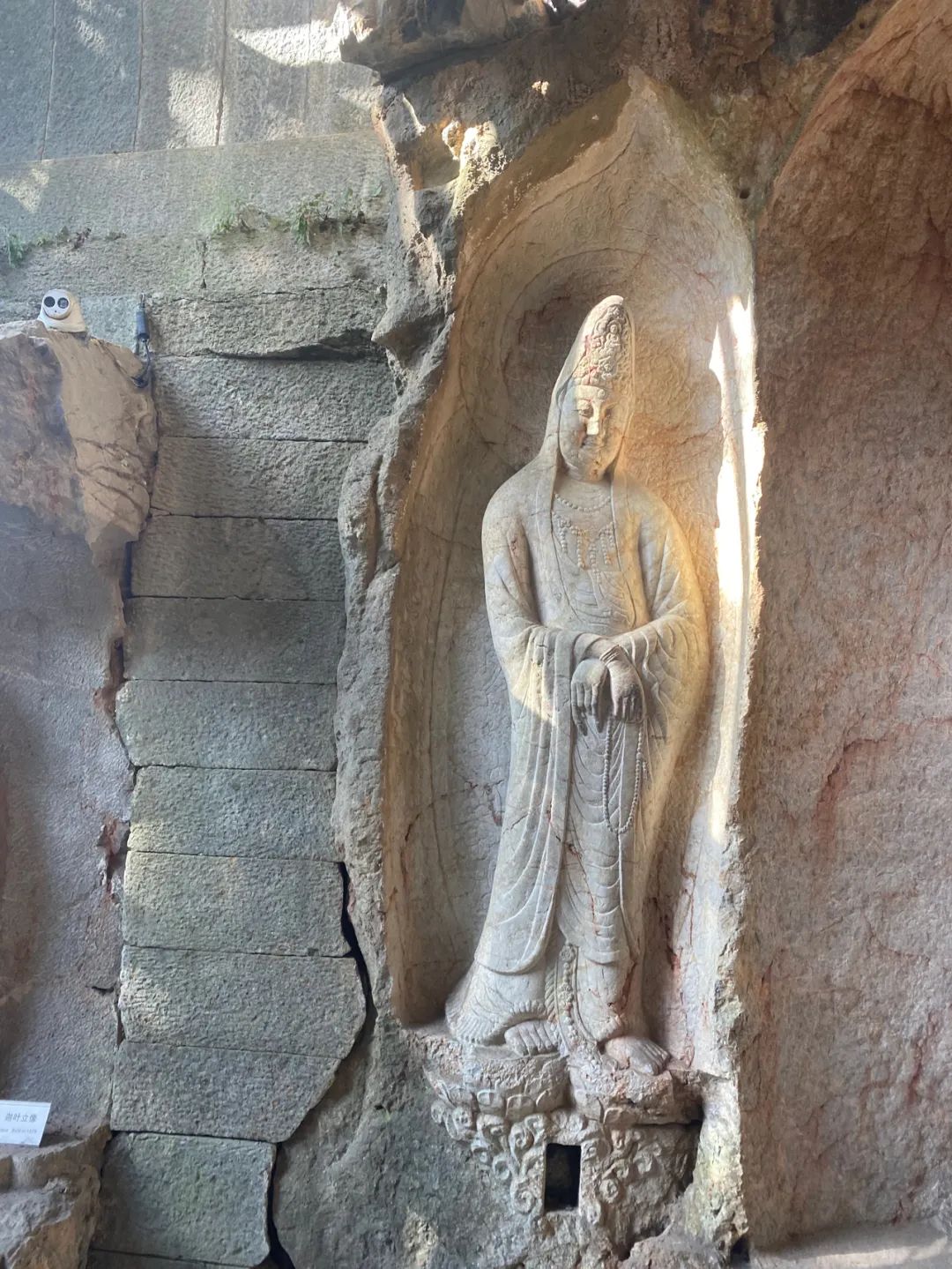
White-robed Avalokitesvara in Yanxia Cave during the Wuyue Kingdom Period
Early grotto statues, such as the Giant Buddha of Shicheng Mountain in Shanxian County in the Southern Dynasties, the Giant Buddha of Yangshan in the Tang Dynasty, and the Giant Buddha of Keyan in the Tang Dynasty, were all popular themes of Maitreya statues at that time, representing the popularity of Maitreya's belief. Until the Wuyue Kingdom period, Maitreya statues tended to be in a fixed form, such as the combination of seven statues in the Xiangyan Courtyard on Jiuyao Mountain and Tianlong Temple on Yuhuang Mountain. Maitreya inherited the style of the sitting Buddha statue in the Tang Dynasty. During the Wuyue Kingdom period, the Mingzhou monk Qihe, commonly known as the cloth bag monk, was deified in the Northern Song Dynasty because of the miraculous miracles incarnated by Maitreya and became a national religion. Since the beginning of the Northern Song Dynasty, the image of a pot-bellied monk with a cloth bag first appeared in Zhejiang, which became a new form of Maitreya statues. The earliest surviving cloth bag Maitreya statues in the Zhejiang Grottoes are the cloth bag Maitreya statues in the 45th and 68th niches of Lengquanxi, Feilaifeng, which were excavated in the early Yuan Dynasty, inheriting the style of the Southern Song Dynasty. In addition, the Maitreya statue at the Great Buddha Temple in Hangzhou at the end of the Northern Song Dynasty took another new path and built a magnificent bust statue, which became another popular trend of Jiangnan statues in the Song and Yuan Dynasties, but it gradually declined in later generations.Guanyin belief became popular in the Central Plains since the translation of the Lotus Sutra in the early 5th century. In the Tang Dynasty, Guanyin, as the bodhisattva of Amitabha Buddha, together with Da Shizhi constituted the "Three Saints of the West", which mainly appeared in the statues of the Pure Land Sutra. During the Wuyue Kingdom period of the Five Dynasties, the belief in the Pure Land popular in the Tang Dynasty continued, and a large number of statues of the Western Three Saints were excavated in the Hangzhou area, such as the Shengguo Temple in Phoenix Mountain, the Ziyan Courtyard in Ciyunling, and the Lingjiu Courtyard in Feilaifeng. At the same time, single statues of Guanyin statues are also quietly emerging, such as Jiangtai Mountain Shilong Courtyard, Feilai Peak Shenni Sherry Pagoda Courtyard, Feilai Peak Lingjiu Courtyard, Yuhuangshan Tianlong Temple, etc., there are single statues of Yangliu Avalokitesvara. Or the image of Shuiyue Guanyin. It is particularly noteworthy that at the entrance of the Yanxia Cave in the South Peak, there is a scene where Yangliu Guanyin and the white-robed Guanyin stand opposite each other. Among them, the Yangliu Guanyin inherits the style of the previous Tang Dynasty, and the white-clothed Guanyin is the first theme of Wu Yueguo, which opened the Chineseization of Guanyin. new road. The Han-style statues of Feilai Peak in the early Yuan Dynasty inherited the complex images of Guanyin in the Southern Song Dynasty. In the shaping of the themes such as Shuiyue Guanyin, White-robed Guanyin, Yangliu Guanyin, Lianlei Guanyin, and Guanyin, they are very artistic and represent the The highest level of statue art in the Song Dynasty. During the Ming and Qing Dynasties, Mount Putuo became a Guanyin dojo, and the statue of Guanyin became more popular, and a wide variety of themes such as fish basket Guanyin, crossing the sea Guanyin, and sending children Guanyin appeared.
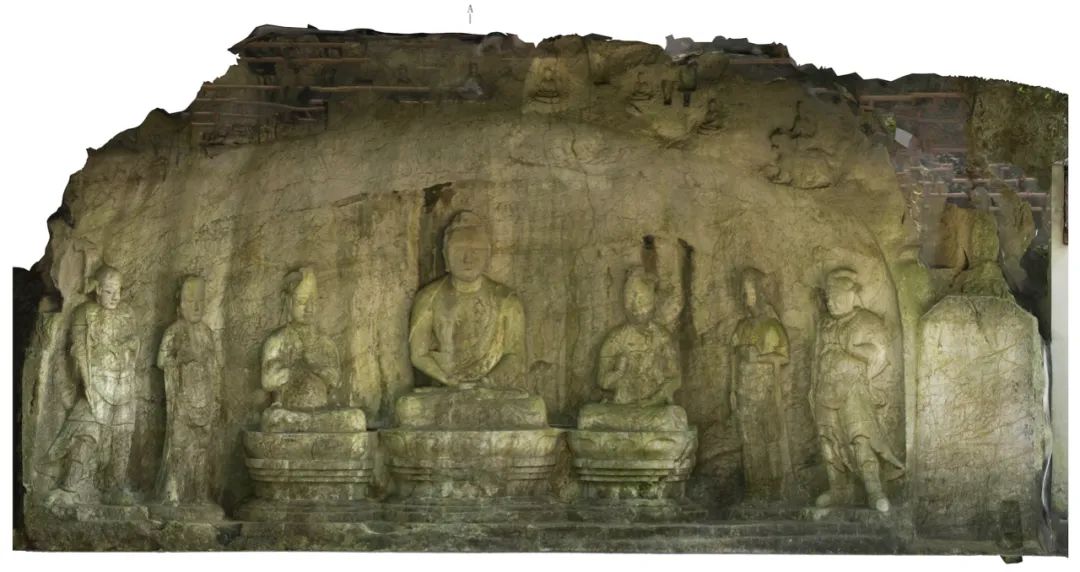
Orthophoto image of the front elevation of the statues of the Three Western Saints, the Bodhisattva and the King of Heaven in the Ziyan Courtyard of Ciyunling during the Wuyue Kingdom period
In the middle of the 7th century, the eminent monk Xuanzang translated "Fa Zhu Ji", and Arhat belief became popular in China from then on. According to Dharma Records, Sakyamuni entrusted his sixteen disciples before Nirvana, not to enter reincarnation, but to live in the world to teach the Fa, as a teacher that all believers in the world should follow. The belief of the Sixteen Arhats was popular in the Tang and Five Dynasties. The 16 Arhat statues in the Shilong Academy in Hangzhou during the Wuyue Period are the earliest extant examples of the 16 Arhats in my country. In the later period of Wu and Yue, on the basis of the Sixteen Arhats, Venerable Qingyou, the author of "Fa Zhuji", and another anonymous Arhat were added to creatively form a combination of the Eighteen Arhats, which became popular in later generations. The Eighteen Arhat statues in Yanxia Cave, Hangzhou, excavated in the third year of Guangshun Wu Yue (953), are the earliest extant example of the Eighteen Arhats statues in my country. In addition, the five hundred Arhats that appeared in the late Tang and Five Dynasties period is another manifestation of Arhat belief. The group of Arhat statues in Shiwudong, Hangzhou, which was excavated in the first year of Wu Yue's first year of luck (944), is the earliest extant example of five hundred Arhat statues in my country. At the end of the Southern Song Dynasty, the two themes of Maitreya in the cloth bag and the Eighteen Arhats created in Zhejiang were creatively integrated into one, as shown in the statue of Maitreya in the cloth bag and the Eighteen Arhats in the 68th niche of Feilai Peak in the early Yuan Dynasty. Examples of theme combinations.The statue of Feilai Peak in Yuan Dynasty was excavated by Yang Lianzhenjia, the president of all Buddhist capitals in Jianghuai. Among them, there are more than 30 Tibetan-style statues, which is the largest group of Tibetan-style grotto statues in mainland my country. Themes include Sakyamuni, Infinite Life, Medicine Master, Aku, Brilliant Light Buddha, Avalokitesvara, Manjushri, Morizhitian, Vajra Brave Consciousness, Vajra Vajra, Zunsheng Buddha, Prajna Buddha, Salvation Buddha, and the Great White Canopy Mother Buddha, King Taman, Zambala, Vajra Hand, Mirivapa, etc. Among them, the nine mandalas of Zunsheng Buddha and Mother Buddha are large in scale; the statues of Duowen Tianwang riding a lion, Mirwapa and his second maid, Zambala, Lion Roaring Avalokitesvara, and nine-headed dragon king are all extremely rare, representing the representative The pinnacle of Tibetan Buddhist art.
In addition, such as the statue of the Sixth Ancestor of Zen Buddhism in the Yuru Cave of Feilai Peak in Hangzhou in the Northern Song Dynasty, the statue of Zhenjun Sanmao in Tongxuan Temple in Hangzhou in the Southern Song Dynasty, the statue of the eminent monk in Longhong Cave of Feilai Peak in Hangzhou in the Yuan Dynasty, and the Ma Ho in the Baocheng Temple in Hangzhou in the Yuan Dynasty. The statue of Ge La, the transfiguration of the Ten Kings Sutra in Xishan Temple in Hangzhou in the Ming Dynasty, and the statue of Jigong in Hugongyan in Yuyao in the Qing Dynasty are all precious statues that are unique in Zhejiang or rare in the country.
4. Inscriptions on the Grotto Statues
Inside and outside the statue niches in grottoes, there are often hand-cut polished panels for engraving inscriptions. In addition to the inscriptions on statues, there are also various contents such as re-installation inscriptions, Buddhist scriptures, and literati inscriptions.
Grotto statues are generally engraved with statues on the side of the niche, explaining the name of the supporter of the statue of Shi Jian, the content of the statue, the cost, the vow, and the age. Statue inscriptions are an important part of grotto statues, and have important values such as dating and characterization. In the period of the Wuyue Kingdom of the Five Dynasties, the Ciyunling Ziyanyuan and the Xiguan Purification Institute were excavated with huge cliff stone tablets in the shape of Guishou, which were used as inscriptions for statues and inscriptions for the establishment of the academy. The five hundred Arhats and other Buddha statues in Shiwudong, because of the large number of donors, even excavated more than 200 square inscriptions, which are rich in content. The inscriptions on the statues of the Arhats in Yanxia Cave, especially the confirmation of the inscriptions of "The Venerable Qingyou" in niche 24, are the key evidence for the origin of the statues of the Eighteen Arhats in Wuyue Kingdom. The statues of Jiuyao Mountain in Hangzhou during the Wu-Yue period were discovered and identified due to the inscription of the "Xiang Yanjie", which made the nature and value of the statues clear. The statues of Tongxuan Temple in Hangzhou in the Southern Song Dynasty are distributed with 11 historical statues and reconstruction inscriptions, including the rich contents of the early construction in the Southern Song Dynasty, the reconstruction in the Yuan Dynasty, and the three constructions in the Ming Dynasty, which can make up for the lack of historical records. The inscriptions of more than ten square statues left in the Feilai Peak statue in the Yuan Dynasty recorded the beginning and end of the statues being built by monks and officials at all levels by the presidents of the Buddhist capitals of Jianghuai. However, there are also a large number of grotto statues inscriptions. Due to the humid climate in Zhejiang, the weathering and dissolution of limestone are serious, and most of the handwriting does not exist. For example, the statue of the God Ni Shri Pagoda in the Wuyue period on the top of Feilai Peak, although it can be confirmed that there are about 30 square statues. There are traces of the inscription, but no word can be identified.
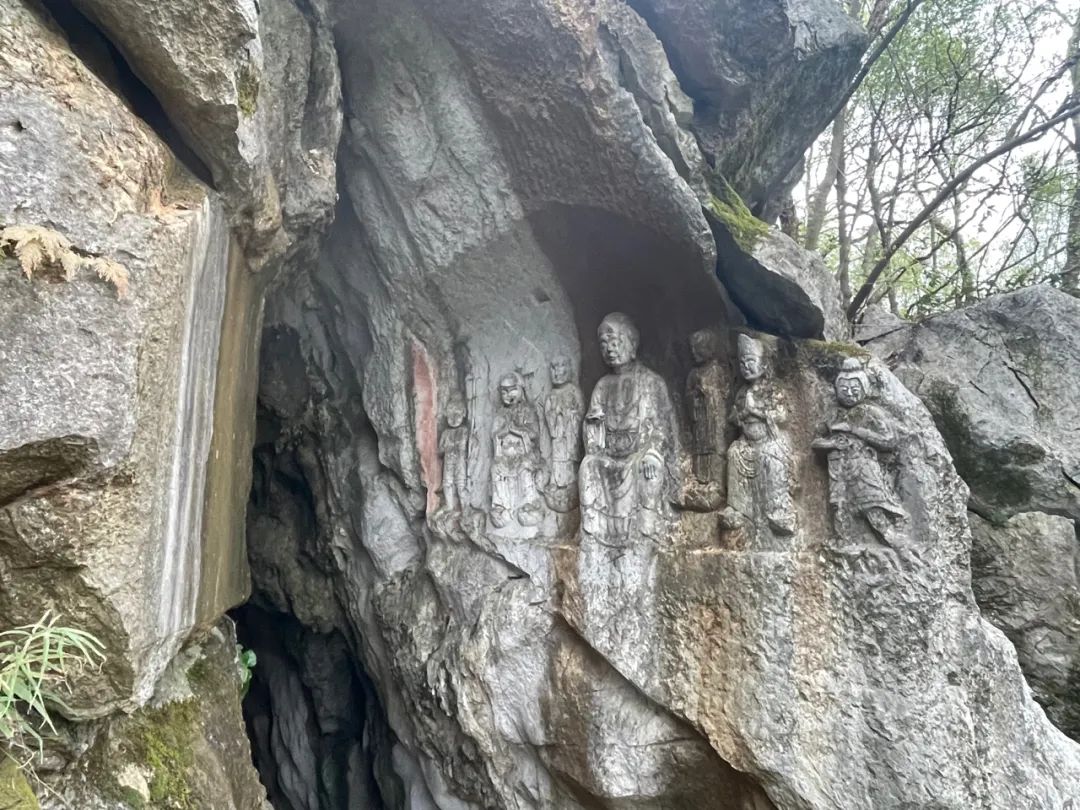
Statues of one Buddha, two disciples, two bodhisattvas, and two heavenly kings on Jiuyao Mountain in Wuyue Kingdom
There is a type of inscription in the grotto, although it is not the original inscription of the statue, but the content is directly related to the statue, such as the re-installed inscription of the statue. In the humid and rainy places in the south of the Yangtze River, although the grotto statues have eaves to shield the wind and rain, it is generally necessary to restore the golden body painting of the Buddha statues after 20 to 30 years. Hangzhou Feilaifeng Longhong Cave, Qinglin Cave, Yuru Cave, Baocheng Temple and other places all have re-installed inscriptions of later generations.Another type of inscription is related to statues, namely Buddhist scriptures. Opposite the Maitreya shrine in the Xiangyanyuan Grottoes in Jiuyao Mountain, the full text of Maitreya's Shangsheng Jing, which was excavated at the same time, is engraved against each other. The cliff wall behind the Shilongyuan Grottoes in Hangzhou during the Wuyue period is engraved with the full text of the "Xinyin Ming" written in the Northern Song Dynasty, with excellent calligraphy.
Of course, there is also a type of inscription that is not necessarily related to the statue, that is, the inscriptions on the cliffs of the literati of the past dynasties. Lu Yuanfu, the governor of Hangzhou in the Tang Dynasty, left a poem "You Tianzhu Temple" in the Shenni Sherry Pagoda on the top of Feilai Peak, which can make up for the shortcoming of "Complete Tang Poems". Inside and outside the Longhong Cave of Feilai Peak, there are a large number of literati inscriptions from the Song Dynasty to the Republic of China, which complement the cave statues of the Yuan Dynasty and form a unique landscape. It should be pointed out that later literati inscribed mountains and rivers, sometimes engraved the inscriptions in the grottoes, and even directly destroyed the content of the statues. The statues in the Stone Buddha Cave on the back mountain of Jingci Temple were excavated in the Wuyue Kingdom period of the Five Dynasties. The three Buddha statues on the main wall and the eighteen Arhat statues on the two walls are mainly composed of inscriptions, poems and big characters written by Hu Zongxian and Ding Hong in the Ming Dynasty four times. destroyed.
A major feature of ancient Zhejiang grotto statues is that they contain a variety of stone inscriptions. Regardless of the inscriptions on statues, re-installed inscriptions or Buddhist scriptures, or the inscriptions on the cliffs that the literati and writers "visited here", they are all organic components of a complete grotto, reflecting the excavation, maintenance, generation of the landscape, acceptance and appreciation of the landscape. , and the historical process that has been damaged to varying degrees in later generations, is indispensable in the investigation and recording of grotto statues.
V. Key Issues in the Research and Protection of the West Lake Grottoes
Finally, taking the statues of the West Lake Grottoes in Hangzhou as an example, the key issues in the research and protection of the grottoes are discussed.
The statues of West Lake are mainly distributed in the limestone mountains such as Feilai Peak, Nanfeng Mountain, Jiuyao Mountain, Yuhuang Mountain, Nanping Mountain, Fenghuang Mountain, Wushan, etc. Because the limestone area has strange rocks and clear mountains and rivers, and because the stone quality is more delicate than other lithology More suitable for opening niches for statues. The main body of the West Lake statues—the Wuyue period statues and the Feilaifeng statues are both located in the limestone area. As for the line from the Dashi Buddhist Temple in the Baoshi Mountain to the Ziyun Cave in the Qixia Mountains, there are indeed examples of statues excavated on volcanic rocks, but only in the Northern Song Dynasty, especially in the Northern Song Dynasty. It was a sporadic activity after the Yuan and Ming Dynasties.
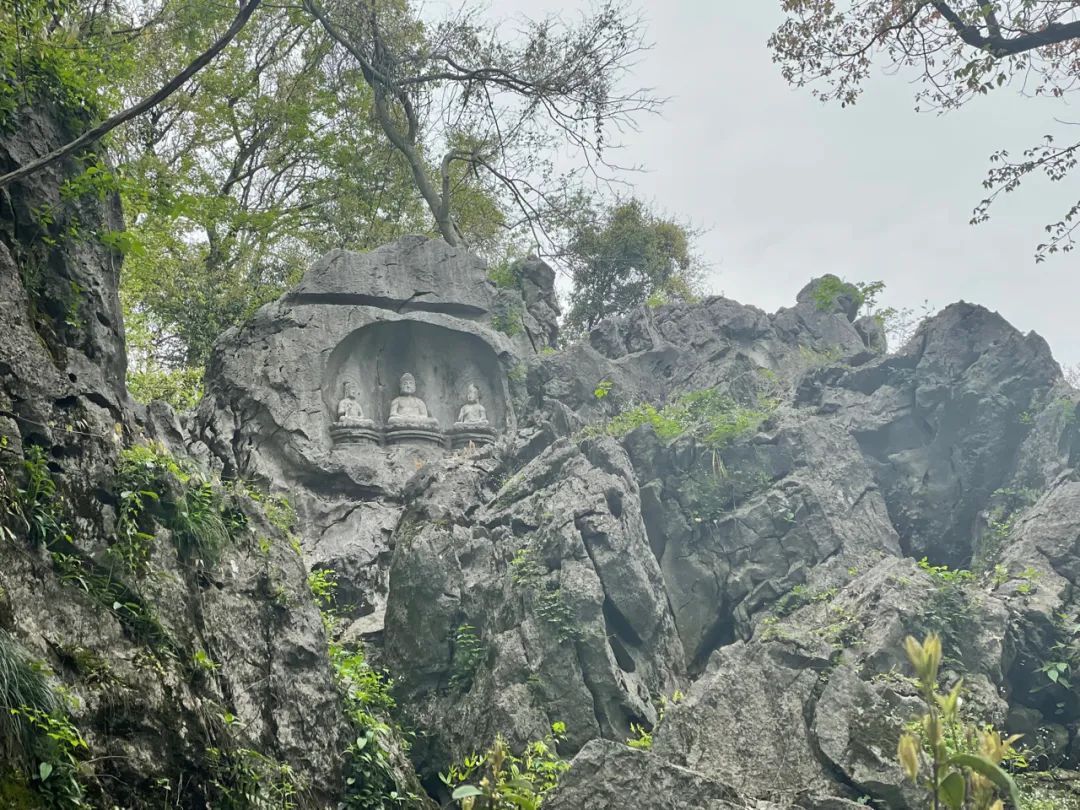
Statues of the Three Western Saints in Niche No. 2 of Feilai Peak, Wuyue Kingdom
The mountains surrounding the lake are bounded by Tianmen Mountain, and the mountains to the north are called "North Mountains", including North Peak, Feilai Peak, Geling, Gem Mountain, etc.; the mountains to the south are called "Nanshan", including South Peak, Nanping Mountain, Jade Emperor Mountain, Phoenix Mountain, Wu Mountain, etc. The West Lake statues are divided into Nanshan statues and Beishan statues. The former is mainly based on the statue of Wuyue Kingdom, and the latter is represented by Feilai Peak. The value and characteristics of cultural relics have their own emphasis.However, in the sixth batch of national cultural relics protection units announced by the State Council in 2006, the statues of Ciyunling, Tianlong Temple and Yanxia Cave were packaged in the name of "Nanshan Statues", and merged with the second batch of national cultural relics protection units Feilaifeng statues. The general name is "Feilaifeng Statue". However, the statue of Feilai Peak includes the statue of Nanshan, but important Wuyue cultural relics such as Shengguo Temple, Shilong Cave, Jiuyao Mountain, and Huiri Peak of Jingci Temple have been abandoned. This unreasonable merger of cultural relics shows that the historical and artistic value of West Lake statues may be lacking in the past cultural relics and archaeology circles.
This question can also be asked in the following way: in the national research system of archaeology and cultural relics protection of cave temples (grotto statues), how should the historical and scientific value of the West Lake statues be refined and interpreted?
Regarding the statues of Nanshan, we believe that the core concept of "Buddhist statues of Wuyue Kingdom" must be put forward, and the nine statues of Ciyunling, Tianlong Temple, Yanxia Cave, Shengguo Temple, Shilong Cave, Huiri Peak and Jiuyao Mountain must be compared with the same period. Buddhist historical sites such as temples and pagodas are integrated and incorporated into the vision of Hangzhou urban archaeology and the history of West Lake landscape formation. The Buddhist historical relics and art supported by the Wuyue royal family are an important part of the study of Buddhist history in my country after the Tang Dynasty.
Regarding the Feilaifeng statue, there is more room for discussion. The second batch of national key cultural protection units "Feilai Peak Statues" announced in 1982 included the statues of the God Ni Shri Pagoda in the Wuyue Period of the Five Dynasties (the area around the top of Feilai Peak), and the statues of the Lingjiu Yuan in the Northern Song Dynasty of the Five Dynasties (Feilai Peak). Qinglin Cave and Yuru Cave in the east), the statues of Lingyin Temple where the President of the Yuan Dynasty was located (Longhong Cave, Lengquanxi and Huyuan Cave in the northern foot of Feilai Peak), folk statues in Ming Dynasty (scattered), etc. Four parts. Their ages, distribution locations, and monasteries are different. When investigating and studying Feilaifeng statues, it is necessary to distinguish them according to the different backgrounds of niche statues. To merge the huge group of caves with different historical backgrounds into one cultural relic of "Feilai Peak Statue" is still a matter of academic theory, and the sixth batch of national cultural relics protection units "Feilai Peak Statue" will have no geographical location. The inclusion of the related Nanshan statues will inevitably lead to confusion of concepts and "out-of-focus" value interpretation.
The core value of the Feilaifeng statue is traditionally believed to preserve the largest group of Tibetan Buddhist statues in the south of the Yangtze River. But this view is not comprehensive. For the time being, there are still many statues of Wuyue Kingdom and Northern Song Dynasty in Qinglin Cave and Yuru Cave. At the time of the Song and Yuan Dynasties, Yang Lianzhenga excavated Tibetan Buddhist statues, and there were also a group of "Han style" in Jiangnan ”, such as the Three Saints in the West in the 98th niche of Huyuan Cave and the three statues of the Buddha of Infinite Life, the Mother of Salvation, and Manjusri in the 99th niche, which were donated and excavated for Yang Lianzhenga. Although the latter is a Tibetan Buddhist theme, it uses The traditional craftsmanship of the Han region, the peaceful posture of the statues, and the rounded patterns on the clothes are the perfect combination of the statue art of the capital city of the Southern Song Dynasty and the themes of Tibetan Buddhism, reflecting the fusion of Tibetan and Chinese cultures. The 68th niche "Budai Monk and the Eighteen Arhats" is a classic statue of Feilai Peak. It is traditionally believed to be a statue of the Southern Song Dynasty. However, today's academic circles believe that it was excavated in the early Yuan Dynasty. , representing the highest realm pursued by Han art. Looking for the long-standing "Song Yun" in Feilai Peak, that is, the statue art of Lin'an City in the Southern Song Dynasty. This perspective, which has been obscured for a long time, can just reveal the era and value characteristics of Feilai Peak statue at the turn of the Song and Yuan Dynasties.
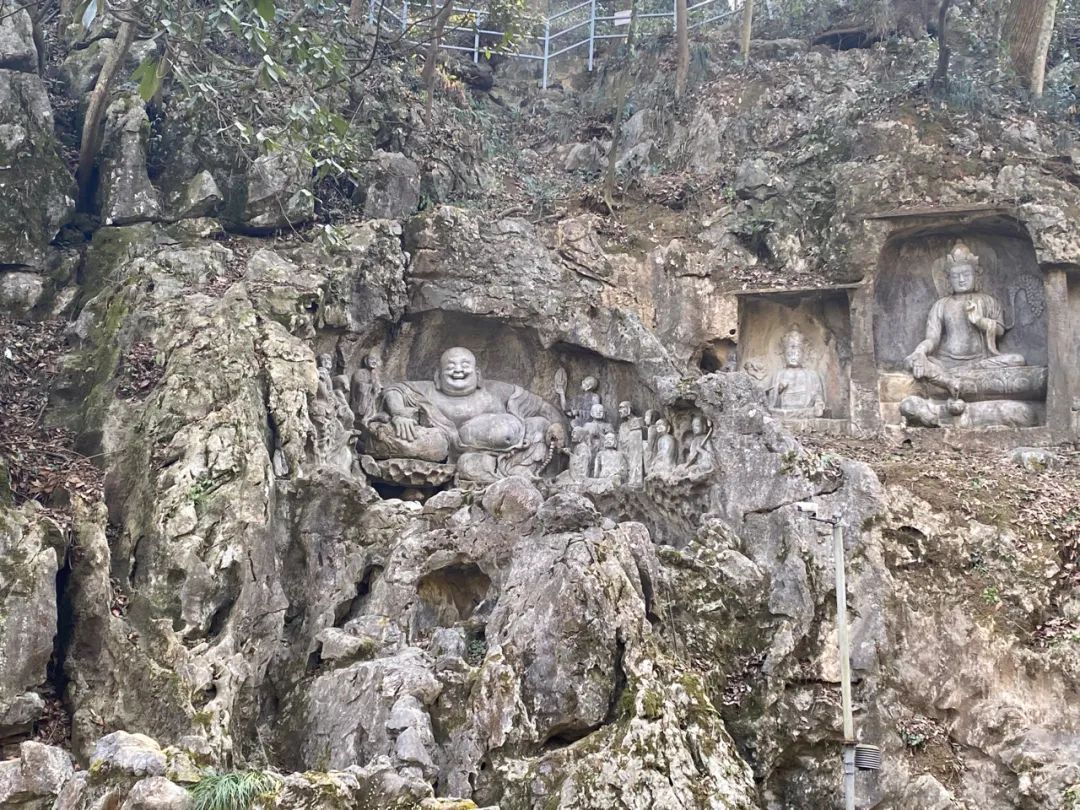
The relationship between the 68th niche in the Yuan Dynasty on Feilai Peak, "The Cloth Bag Monk and the Eighteen Arhats", the surrounding statues and the mountain

Orthophoto image of the statues of the Three Saints of the West donated by Yang Lianzhenga in the 98th niche of Feilai Peak
The outstanding value of the statues of Nanshan and Feilaifeng is not deep in the city of Hangzhou and cannot be discerned by Buddhist historians, but is easily overlooked or concealed. The corresponding academic status in the temple archaeological system is all related to this.The ancients always used "golden stone longevity" as a metaphor for long life. In fact, due to the influence of natural factors such as rain erosion, weathering, rock mass instability, etc., the grotto statues in the fields are quite fragile. Excavation of statues in limestone mountains and limestone caves that are prone to dissolution is a feature of West Lake statues, which brings serious challenges to the protection of grottoes. The physical and chemical protection of limestone cultural relics in the open air, rainy and humid environment in the south of the Yangtze River is a scientific and technological problem that needs to be tackled urgently. We expect scientific and technological workers in cultural relic protection to invent in this field. The streamer is wiped out.
(This article is reproduced from Zhejiang Archaeology, with the original title "Overview of Ancient Zhejiang Grotto Statues")